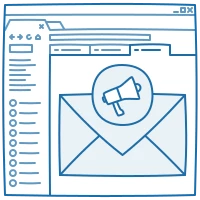10 July 2020
12404
8 min
5.00

Gmail Inbox Tabs in Email Marketing: Primary vs. Promotions
Gmail is one of the most popular email clients in the world. But its Inbox categories launched in 2013 have been facing as strong opposition as Spam. Although you can come across numerous expert tips advising on how to get your emails into Primary, it looks like no one really knows how the Gmail tab filters work and how to tilt them in your favor. But is it actually so?
What Tabs Gmail Has
The purpose of such categorization is to help users optimize their Inbox tabs and protect them from spam and unsolicited emails.
Gmail categories are the following (first three are default):
- Primary – personal correspondence;
- Social – messages from social media (Twitter, LinkedIn, Facebook, Instagram);
- Promotions – all emails with commercial content;
- Updates – automated notifications on updates (delivery confirmation, receipts, Google Docs messages);
- Forums – messages from forums, groups.

You can change them in Settings > Inbox by enabling the necessary category.

How Gmail Filters Work
Email delivery expert Chris Lang says that Gmail has about 450-550 different parameters that serve to analyze and send each email to the corresponding tab. Naturally, filter conditions get better and more sophisticated every year.
In general, there are three parameters Gmail filters pay attention to when allocation emails between tabs:
- Technical characteristics. First of all, Gmail checks the IP the email was sent from, its sender reputation, email address, SPF authorization, etc.
- Content similarity. Email content is compared based on the analysis of similar emails from the same sender or different senders (similar topic theme, industry, company type).
- Behavioral characteristics. This analysis is based on subscriber activity and their engagement with emails. A high bounce rate, unsubscribe rate and numerous spam reports can be a signal that subscribers are not interested in your content.
Of course, the more complex the system, the more chances it may have certain calculation errors. And yet, 90.8% of users respond that Gmail accurately sorts their emails (according to Guide to Gmail Categories by Validity).

Email Delivery You Can Rely On
How Tabs Perform
According to Validity,
- 33.8% of users use tabs in Gmail to sort emails;
- Social (68.1%) and Promotions (60.0%) are most often enabled tabs;
- 11.9% of users constantly check the Promotions tab and 19.9% never do;
- Updates (28%) have the highest read rate and Promotions (19.2%) have the lowest.

And although people who open emails in the Gmail Promotions tab are more likely to make a purchase as they intentionally opt to read and consider commercial content, some marketers see getting to the Primary tab as a key factor that determines the success of the campaign.
As a result, you may come across various hacks on how to break down the Primary tab. Most typical include:
- Stick to the 40/60 image-to-text ratio. Too many images and too little text immediately send your email to Promotions. As a rule, people don't send each other a lot of pictures in the email body.
- Include minimum links. Add 2-3 links per email.
- Delete social media icons. They are mostly typical of bulk emails.
- Replace the text of standard links. For example, View in browser and Unsubscribe are default text typical of commercial content. Rewrite it with more custom options, I no longer want to receive from you, etc.
- Get personal. Address a subscriber by their name if you know it.
- Change a sender name. Subscribers may react better to a new sender.
- Send on behalf of a person not a company. Make your campaigns more human-like.
- Suggest answering your emails. Correspond with your audience like with friends.
- Be laconic. Too long HTML email can be cut. Besides, they don't look very personal.
- Send plain text. Emails with images more often get to Promotions.
Some of the above (like image-to text ration) may be useful, but in general such tips aren’t applicable to commercial emails. A plain text short email without images, links, social media icons, and answer prompting won’t make anyone buy your product, even if they do get to Gmail Primary. What’s more, a person may be annoyed by emails that get too pushy and intrusive, sneaking into tabs they aren’t intended for. Such annoyance can result in an unsubscribe or spam report, which will hurt your further deliverability.
Gmail created Inbox categories and filters to protect users from irrelevant information and help optimize email reading. So instead of looking for ways to break down its algorithms, it’s better to focus on proper segmentation, content personalization and analytics.
How to Reach Your Subscribers in Gmail
The most important advice we can give here is to make campaign relevance the top priority of your marketing strategies. Don’t try to fool Gmail algorithms; win subscribers’ interest and trust instead.
1. Send useful content.
Create emails which users would be glad to mark as important. What can make people interested in not missing out on your messages?
- Contact segmentation. Send right emails to the right people based on their personal data, location, language preferences, interests, shopping history, etc.
- Personalization. AI-supported content optimization, scheduling, personal product recommendations with relevant brands and price categories – each email should look as if it was hand-made personally for this recipient.
- Dynamic content. It’s not possible to spend much time and resources on designing each email unique. But including AMP elements, rollovers, animation, gamified content, and video will make people looking forward to hearing from you.
2. Categorize emails.
Single transactional messages have the biggest chances of getting to Primary. Therefore, it is better to separate different types of emails and use different sender names.
- newsletters – our Blog;
- bulk promos – our platform;
- events – our Events;
- news – our Updates;
- triggered messages – our Orders, etc.
But be careful when adding new addresses and senders. Your reputation is linked to your email address and is associated with the email content. By changing a sender regularly, you start gaining the trust of the email client from scratch.
If you have a bad reputation and have started experimenting with sender names, Gmail filters will send you to Spam, and it’s always really hard to unspam and become a trustworthy sender.
3. Ask subscribers to move you to the Primary tab.
If a recipient is interested in your emails, ask them to move you to another tab so they don't miss anything important.
- Send a separate email.

This email was sent as soon as tabs in Gmail were launched. But you can also use this approach to ask your loyal audience to prioritize campaigns from you.
- Give plain text instruction.

- Make a separate block for Gmail users.

Include such a block with an illustrative GIF into your regular promo campaigns.
There are two options to make this block seen by Gmail users only:
- use a dynamic block. Create an additional field for users who will see this block;
- create a dynamic segment. Group users who have an email address with the corresponding domain.

Thus, users of other email clients will not be confused by you offering to somehow manage their Inboxes.
Don’t try to outsmart Gmail algorithms. Machine learning nowadays is being developed at extreme speed, so it will always be one step ahead of your most sophisticated tricks. Instead, focus on content relevance and subscriber satisfaction. People would respond to your offers in whatever tab if they deliver use and benefits.



Login: